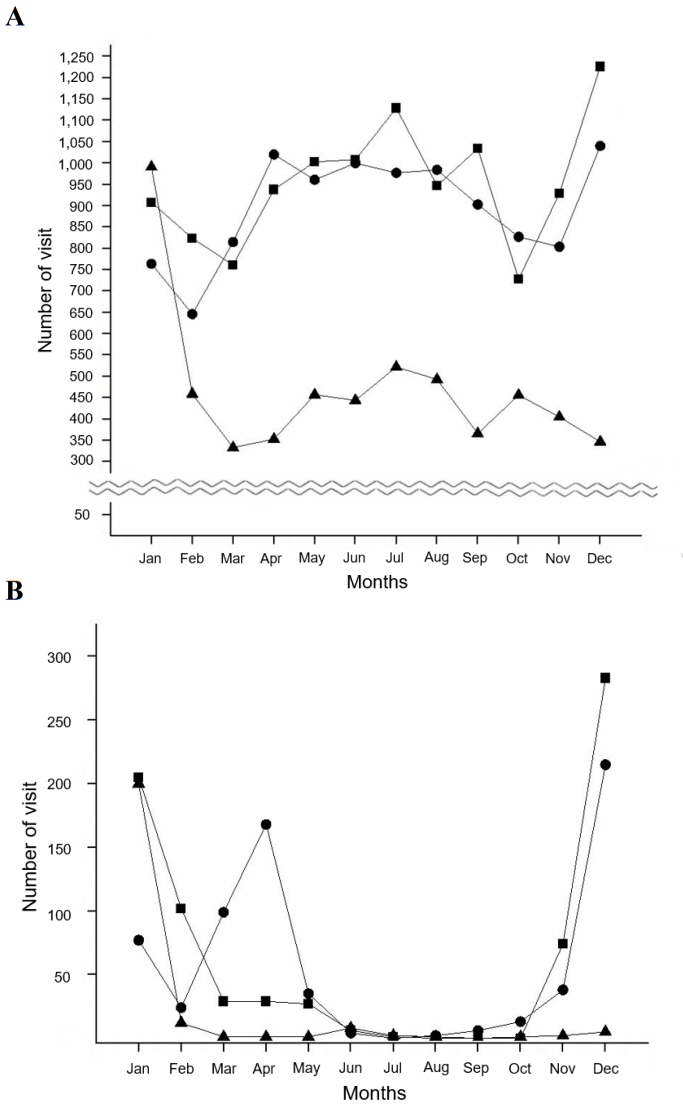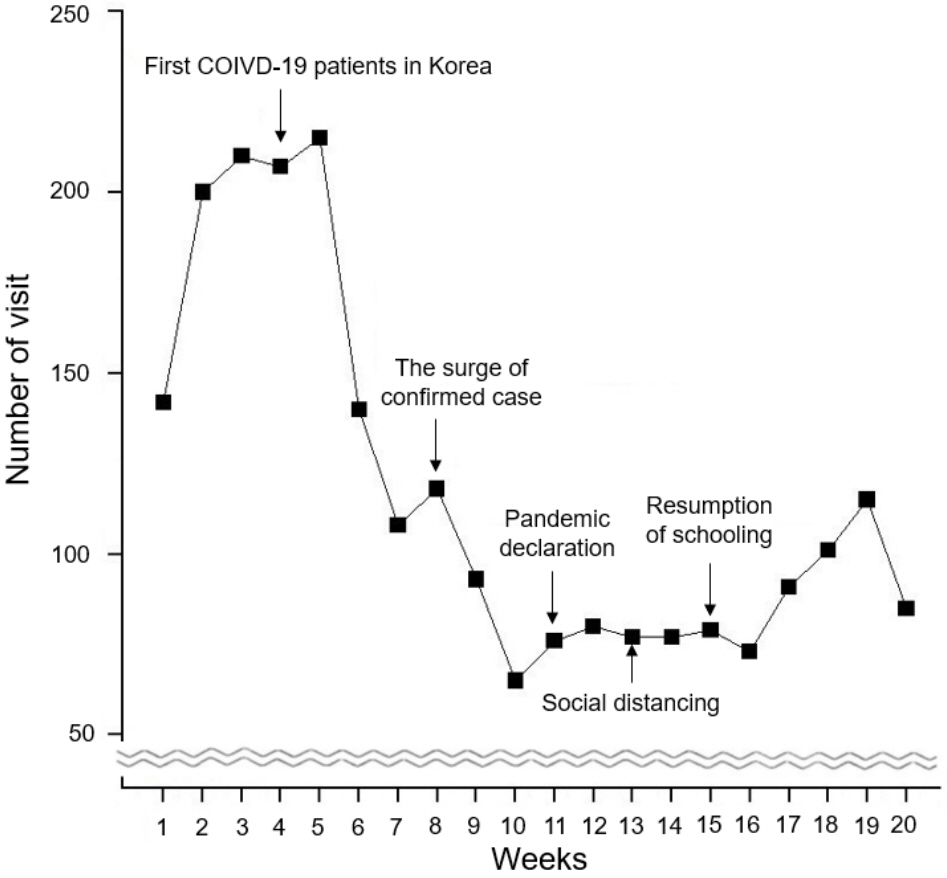Pediatr Emerg Med J.
2022 Jun;9(1):29-34. 10.22470/pemj.2022.00451.
Coronavirus disease 2019 pandemic-related change in children’s visits to the emergency department
- Affiliations
-
- 1Department of Emergency Medicine, Catholic Kwandong University International St. Mary’s Hospital, Incheon, Republic of Korea
- KMID: 2531526
- DOI: http://doi.org/10.22470/pemj.2022.00451
Abstract
- Purpose
This study was performed to investigate the coronavirus disease 2019 pandemic-related changes in visiting pattern of an emergency department (ED).
Methods
The author investigated all children younger than 19 years who visited the ED from 2018 through 2020 without exclusion criteria. Pandemic period was defined as 2020. Variables of interest were monthly and annual numbers of visits, age and age groups (< 1, 1-4, 5-9, 10-14, and 15-18 years), sex, visits for diseases, disposition, high acuity, and top 5 chief complaints per each age group. Timing of social distancing and influenza-related visits were additionally analyzed to speculate the impact of such variables on the visiting patterns.
Results
The annual visits were 11,435 (2018), 10,741 (2019), and 5,626 (2020), with a 47.6%-50.8% pandemic-related decrease. Trauma-related visits increased from 27.7%-28.4% to 36.5% (P < 0.001). In the children aged 9 years or younger, trauma as a chief complaint increased from 22.2%-29.6% to 36.2%-42.5% while fever decreased from 27.7%-47.3% to 16.7%-42.6%. In the pre-pandemic period, visits increased in February-March and October-December with a sharp increase in influenza-related visits in the latter 3 months. During the pandemic, a sharp decline in the visits was noted in January-February without the above-mentioned increasing patterns in neither total nor influenza-related visits. After the social distancing was implemented in the 13th week of 2020, the visits remained steady until a slight increase was noted after the school opening.
Conclusion
During the pandemic period, a decrease was noted in the numbers of visits to the ED, along with decreases in fever as a chief complaint in young children and influenza-related visits, and the mitigation of social distancing. These findings could be useful in preparing emergency medicine resources for ongoing and future pandemics.
Figure
Reference
-
References
1. Choi DH, Jung JY, Suh D, Choi JY, Lee SU, Choi YJ, et al. Impact of the COVID-19 Outbreak on trends in emergency department utilization in children: a multicenter retrospective observational study in Seoul metropolitan area, Korea. J Korean Med Sci. 2021; 36:e44.
Article2. Hwang SY, Lee JK, Ryu HS, Park SS, Choi JY, Lee HJ, et al. Long-term impact of coronavirus disease 2019 pandemic on emergency department utilization in a metropolitan emergency department in Korea. Pediatr Emerg Med J. 2021; 8:57–65. Korean.
Article3. Kim JA, Son MH, Park M. Effect of coronavirus disease 2019 on febrile children’s visits to the emergency department of a tertiary hospital. Pediatr Emerg Med J. 2021; 8:8–15.
Article4. Kim HM, Ha SO, Yang WS, Park YS, Kim JH. Effect of coronavirus disease 2019 pandemic on children’s visits to the emergency department. Pediatr Emerg Med J. 2022; Jan. 12. [Epub]. https://doi.org/10.22470/pemj.2021.00381.
Article5. Pines JM, Zocchi MS, Black BS, Carlson JN, Celedon P, Moghtaderi A, et al. Characterizing pediatric emergency department visits during the COVID-19 pandemic. Am J Emerg Med. 2021; 41:201–4.
Article6. Scheier E, Levick N, Guri A, Balla U. The injury-illness dichotomy of COVID-19 on the pediatric ED. Am J Emerg Med. 2022; 52:244–8.
Article7. Isba R, Edge R, Auerbach M, Cicero MX, Jenner R, Setzer E, et al. COVID-19: transatlantic declines in pediatric emergency admissions. Pediatr Emerg Care. 2020; 36:551–3.8. Dopfer C, Wetzke M, Zychlinsky Scharff A, Mueller F, Dressler F, Baumann U, et al. COVID-19 related reduction in pediatric emergency healthcare utilization–a concerning trend. BMC Pediatr. 2020; 20:427.9. Jung JH, Kwak YH, Noh H. Strengthening the role of pediatric emergency centers in Korea. Pediatr Emerg Med J. 2017; 4:29–33. Korean.
Article10. Fraymovich S, Levine DA, Platt SL. A blueprint for pediatric emergency resource reallocation during the COVID-19 pandemic: an NYC hospital experience. Pediatr Emerg Care. 2020; 36:452–4.11. Bellini T, Piccotti E. A potential impact of the donning and doffing policy on emergency department length of stay during the coronavirus disease 2019 pandemic. Pediatr Emerg Med J. 2021; 8:124–6.
Article
- Full Text Links
- Actions
-
Cited
- CITED
-
- Close
- Share
- Similar articles
-
- Changes in pediatric injury-related visits during coronavirus disease 2019 pandemic at a single regional emergency medical center in Korea
- Changes in pediatric psychiatric emergency during the coronavirus disease 2019 pandemic
- Effect of coronavirus disease 2019 pandemic on children’s visits to the emergency department
- Clinical aspects of patients visiting the emergency department with febrile seizure
- Long-term impact of coronavirus disease 2019 pandemic on emergency department utilization in a metropolitan emergency department in Korea



